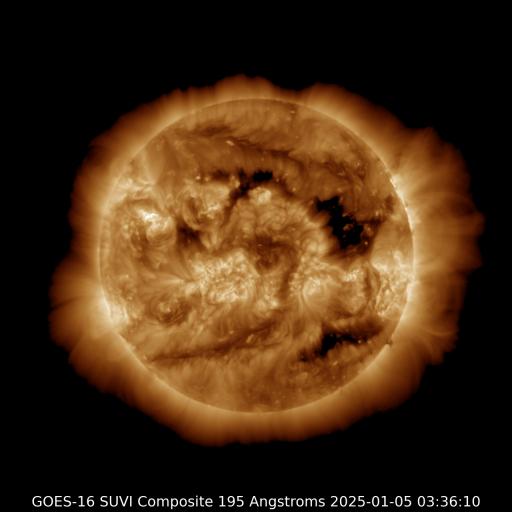Viewing archive of Tuesday, 17 February 2009
Solar activity report
Any mentioned solar flare in this report has a scaling factor applied by the Space Weather Prediction Center (SWPC). Because of the SWPC scaling factor, solar flares are reported as 42% smaller than for the science quality data. The scaling factor has been removed from our archived solar flare data to reflect the true physical units.
Report of Solar-Geophysical Activity 2009 Feb 17 2201 UTCPrepared by the NOAA © SWPC and processed by SpaceWeatherLive.com
Joint USAF/NOAA Report of Solar and Geophysical Activity
SDF Number 048 Issued at 2200Z on 17 Feb 2009IA. Analysis of Solar Active Regions and Activity from 16-2100Z to 17-2100Z
Solar activity was very low. No flares were observed
during the period. The visible disk remains spotless.
IB. Solar Activity Forecast
Solar activity is expected to be very
low.
IIA. Geophysical Activity Summary 16-2100Z to 17-2100Z
The geomagnetic field was quiet. During the period, solar wind speed
steadily decreased from about 440 km/s to near 375 km/s. The
greater than 2 MeV electron flux at geosynchronous orbit was at high
levels again today.
IIB. Geophysical Activity Forecast
The geomagnetic field is
expected to be at quiet levels for the next three days (18 - 20
February)
III. Event Probabilities 18 Feb to 20 Feb
| Class M | 01% | 01% | 01% |
| Class X | 01% | 01% | 01% |
| Proton | 01% | 01% | 01% |
| PCAF | Green | ||
IV. Penticton 10.7 cm Flux
Observed 17 Feb 071 Predicted 18 Feb-20 Feb 070/070/070 90 Day Mean 17 Feb 069
V. Geomagnetic A Indices
Observed Afr/Ap 16 Feb 002/003 Estimated Afr/Ap 17 Feb 002/004 Predicted Afr/Ap 18 Feb-20 Feb 005/005-005/005-005/005
VI. Geomagnetic Activity Probabilities 18 Feb to 20 Feb
| A. Middle Latitudes | |||
|---|---|---|---|
| Active | 05% | 05% | 05% |
| Minor storm | 01% | 01% | 01% |
| Major-severe storm | 01% | 01% | 01% |
| B. High Latitudes | |||
|---|---|---|---|
| Active | 10% | 10% | 10% |
| Minor storm | 01% | 01% | 01% |
| Major-severe storm | 01% | 01% | 01% |
All times in UTC
Current data suggests there is a slight possibility for aurora to appear at the following high latitude regions in the near future
TórshavnOulu, Rovaniemi, Kuopio, Sodankylä, Utsjoki
Kirkenes, Tromsø, Trondheim
Arkhangelsk, Murmansk
Kiruna, Luleå, Sundsvall, Umeå
Latest news
Latest forum messages
Sunspot Latitudes at or near Solar Maximum 85Incoming & Unnumbered Active Regions 1677AR4048 126New satellites - Proba-3, PUNCH, SWFO-L1, GOES-U/19 47AR 4054 21
More topicsSupport SpaceWeatherLive.com!
A lot of people come to SpaceWeatherLive to follow the Sun's activity or if there is aurora to be seen, but with more traffic comes higher server costs. Consider a donation if you enjoy SpaceWeatherLive so we can keep the website online!

Latest alerts
15:15 UTC - Geomagnetic activity
Minor G1 geomagnetic storm (Kp5) Threshold Reached: 14:59 UTC
06:30 UTC - Type II Radio Emission
Begin Time: 08/04/2025 05:53 UTC Estimated Velocity: 456km/sec.
05:15 UTC - Hemispheric Power Index
The OVATION model predicts the Hemispheric Power Index to reach 50GW at 06:02 UTC
00:55 UTC - Coronal hole
A southern hemisphere coronal hole is facing Earth. Enhanced solar wind could arrive in ~3 days
Monday, 7 April 2025
20:45 UTC - Geomagnetic activity
Active geomagnetic conditions (Kp4) Threshold Reached: 20:39 UTC
Space weather facts
| Last X-flare | 2025/03/28 | X1.1 |
| Last M-flare | 2025/04/05 | M1.0 |
| Last geomagnetic storm | 2025/04/06 | Kp5 (G1) |
| Spotless days | |
|---|---|
| Last spotless day | 2022/06/08 |
| Monthly mean Sunspot Number | |
|---|---|
| March 2025 | 134.2 -20.4 |
| April 2025 | 151.3 +17.1 |
| Last 30 days | 135.2 -4.5 |





